
GUIDELINES FOR IDENTIFYING AN EMERGENCY INCIDENT COMMAND POST LOCATION
Typically, when a large scale emergency incident occurs, a command post is established. The command post provides a mechanism for emergency responders and management to converge to effectively coordinate and discuss the ongoing response efforts during an incident. The emergency response command post becomes the “home base” or epicenter for directing coordinated emergency response operations.
There should be numerous pre-planned, incident command post locations identified. The command site for a specific incident should be chosen based on the location of developing circumstances, safety, and the accessibility of a reliable communications system. Emergency managers should use the following guidelines to identifying acceptable locations to serve as a command post:
- Adequate space for size of staff and contracted responders
- 24-hour accessibility
- Ensure personal hygiene facilities
- Provides adequate shelter from natural elements
- Ensure suitability of existing communications resources (phone/fax/radio and/or internet)
- Ensure suitability of private conference and briefing rooms
- Identify Command Post security requirements, safe location
- Notify other parties of Command Post location; provide maps/driving directions
- Determine staging areas and incident base locations
- Identify future need to move, upgrade facilities
Normal, daily company communications may be conducted via telephone lines, cellular telephones, two way radios, e-mail, fax machines, and pagers. However, in an emergency, additional communications equipment such as portable radios with chargers and accessories, may be necessary to implement emergency communication procedures. This equipment may be provided by the company or leased from a communications company in the area. Communications with government agencies, state police, specific municipalities, and identified contractors can be conducted on portable radios. Emergency managers should ensure that incident command post communication equipment includes:
- Adequate phone lines per staff element
- Adequate fax lines
- Computers and internet access, if necessary
- Recharging stations for cellular phones
- Adequate number of VHF radios
- VHF radio communications:
- Establish frequencies
- Assign call signs
- Distribute radios
- Establish communications schedule
- Recharging stations for VHF radios
- Determine need for VHF repeaters
- Copy machine/scanner availability












